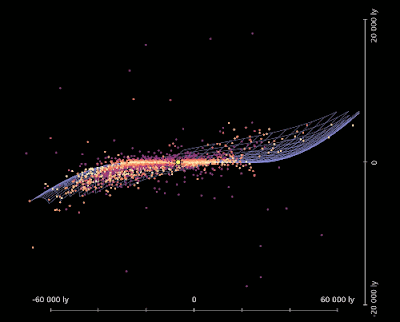An international team of researchers has created the most accurate three-dimensional map of the Milky Way, and the findings have been reported in the journal Science.
Researchers created a 3D map that shows the S-shaped structure of the Milky Way galaxy’s combined star disc, our cosmic address, by calculating the distance from our Sun to hundreds of pulsating stars spread around our galaxy.
Our planet isn’t flat, and guess what? Neither is our galaxy.
“Our map shows that the Milky Way disk is not flat. Instead, it is deformed and twisted in shape,” revealed study co-author Przemek Mróz of the University of Warsaw in Poland.“This is the first time we can use individual objects to display it in three dimensions,” he added.
Much of our present understanding of the spiral shape and structure of our galaxy is based on indirect observations of celestial objects and conclusions based on other distant galaxies in the Universe.
However, as scientists have discovered, the galactic map provided by these restricted observations is insufficient.
The classical Cepheids (giant stars that burn hundreds, if not thousands, of times brighter than our Sun) pulse frequently and are visible through the huge interstellar dust clouds that often cover less luminous interstellar objects, much like numerous distant lighthouses.
Distances to these stars may be estimated precisely owing to periodic fluctuations in brightness.
Dorota Skowron of Warsaw University, in collaboration with scientists from Ohio State University in the United States and the University of Warwick in the United Kingdom, traced the distance to over 2,400 cepheids along the Milky Way, the majority of which were discovered by the Optical Gravitational Lensing Experiment (OGLE), a project that helped double the number of known galactic classical cepheids.
The researchers were able to create an extremely precise three-dimensional model of the Milky Way by assigning coordinates to each distant pulsing star in reference to our Sun.
As a consequence, a beautiful, never-before-seen map of the Milky Way Galaxy has been created.
The findings of the study have helped astronomers better grasp our cosmic surroundings and precisely depict the form of the galaxy.
And it’s not flat, but it does have an unusual form.
As noted by Space.com, “this new map helped reveal more details on distortions that astronomers had “previously detected in the shape of the Milky Way.”
The map took scientists six years to create, but as participating astronomers disclosed, “it was worth it.”
At a distance of almost 25,000 light-years from the galactic core, we discovered that the galaxy’s disc is not flat. It’s twisted. This bending might have been generated by interactions between the galaxy and nearby galaxies, intergalactic gas, or even dark matter.
“Warping of the galactic disk has been detected before, but this is the first time we can use individual objects to trace its shape in three dimensions,” explained Mróz in a statement.
The quantity of ‘warping’ observed in our galaxy was shockingly pronounced, according to the researchers.
“It is not some statistical fact available only to a scientist’s understanding,” Mróz said. “It is apparent by eye.”
Source: amazingastronomy.thespaceacademy.org










